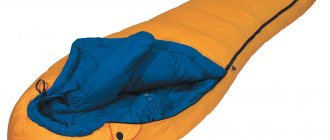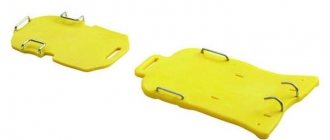Lovers of nature walks, fishermen and hunters have many devices to comfortably cover the intended route. Modern snowshoes help you avoid getting stuck in deep snowdrifts and move quickly. This piece of equipment is as important as a first aid kit or sleeping bag.
What are snowshoes?
Since ancient times, people tied planks to their feet to make it easier to move through snowdrifts in winter. Such devices significantly reduced the pressure on the snow cover. Thanks to this, the person did not risk being waist-deep in ice shackles. Over time, such equipment gained popularity among lovers of winter fun. Modern snowshoes are devices made of durable and lightweight material. Not a single hike, walk in the mountains or hunting in the cold season can be done without them.
What do snowshoes look like?
Devices to facilitate movement are widespread among climbers, hunters and athletes. They say snowshoes are an indispensable part of any walk in the winter forest or hike in the mountains. They have almost the same design. There are only slight differences that depend on the purpose of the equipment. According to their design features, snowshoes are divided into two types:
- Frame
, designed to move through deep and loose snow. The snowshoe platform is wide. The structure itself consists of a frame, fastenings, a deck, a heel, a cat and tightly stretched material or belts and ropes intertwined. - One-piece
, suitable for hiking in the mountains. Snowshoes are made of durable plastic or metal. Their design consists of bindings, deck, heel and heel lift. This type of equipment promotes comfortable movement over difficult terrain: fine-grained ice, hard snow crust.
The shapes of snowshoes are:
- Oval, designed for greater stability on flat surfaces.
- Pointed, used for high-speed movement. Such models are convenient for making maneuvers and turns.
Choosing the Right Snowshoes
The purchase of a particular model depends on the purpose, type of terrain and snow structure. Gender and weight are also taken into account. Women's snowshoes differ in the shape of the platform and the size of the fastening. The point is that they are designed to be used with boots of a smaller size and weight of a hiker. Also designed for shorter strides. In men's varieties, a wide platform prevails and the ability to use with large shoe sizes.
Snowshoes can withstand weights of up to 140 kilograms. The smallest load capacity is 80 kilograms. This parameter takes into account the weight of the traveler himself and his backpack.
When trying on, you need to pay attention to which fastening system is most suitable. The main signs that the choice was made correctly:
- it turns out to be so easy to adjust the fastenings that this can be done even in difficult weather conditions;
- the fastenings themselves do not loosen;
- nothing presses through the shoe. Otherwise, during the hike, the discomfort will increase several times.
- The leg is held well, does not slide to any side and does not dangle.
Which is better, snowshoes or skis?
To move through snowdrifts in the winter, a person can use various devices. The most popular are touring skis and snowshoes. The first are suitable for riding, but the other device for moving on snow is intended for winter hiking and conveniently covering long distances. The obvious advantages of their use are:
- Compact size and light weight
. The weight of the equipment is only 1.5-2 kg. - Convenient transportation
. So snowshoes can be easily placed in a car, transported on public buses, on the subway, or attached to your back or backpack. - High maneuverability
. Unlike long touring skis, snowshoes do not restrict the movement of an athlete or hunter. They corner faster and don't slow down. - Possible use for any terrain
. In snowshoes you can wander through a dense forest, climb mountains, or move across a frozen pond. - Easy operation
. Using the equipment does not require special training. You just need to stay on your feet and be a lover of an active lifestyle.
Why are snowshoes needed?
First, let's look at what snowshoes are. The first improvised products appeared in the Paleolithic era, when people first encountered snow drifts.
Planks or lattice devices tied to the feet increased the area of the foot, reducing pressure on deep snowdrifts (a person moved along the surface without the risk of falling waist-deep and being trapped in snow).
Since the mid-twentieth century, snowshoe skis have experienced a rebirth, gaining popularity among lovers of winter activities. Now not a single winter hike, hunt or mountain walk is complete without a useful device. Fortunately, you can buy snowshoes at any specialized store.
Feel free to purchase equipment if you can’t imagine your life without:
- Hiking on winter off-road terrain: snow-covered forest paths, steppe expanses, etc.
- Walking along the mountain slopes in the spring-winter period (when the snow in the highlands has not yet melted).
- Mountaineering, and not only winter (it’s easier to get to the top in snowshoes, safely cross a closed glacier, etc.).
- Backcountry: skiing or snowboarding (makes it easier to approach and climb to the starting point).
- Competitions, running, complex multi-races with mandatory stages of the snowshoe race.
- Winter hunting, fishing.
- Geological expeditions.
If we are not talking about skiing, but about quickly and conveniently covering a distance, snowshoes are a worthy alternative to touring skis.
And that's why:
- weigh less (only 1.5-2.5 kg), more compact, more convenient to transport - easy to attach to a backpack, transport in a car or public transport;
- suitable for almost any winter terrain - you can go up or down a mountain slope, wander through the wild taiga;
- They are distinguished by high maneuverability - they do not hinder movement where it is impossible to turn around on long skis;
- do not require special training.
How to choose snowshoes?
Before purchasing winter equipment, you need to decide on their purpose. The design of snowshoes and methods of attaching them depend on this. There are the following types of snowshoes:
- For walks in winter
. These are lightweight folding snowshoes. They have the simplest design, designed for hiking in a snowy forest, frozen pond, or open space. This equipment performs well on flat areas and on terrain with a slight slope. Suitable for hunters. These models of snowshoes are attached to any shoes: boots, shoes. - For mountaineering and mountain hiking
. Such models are made of heavy-duty plastic. The rigid structure is equipped with spikes and is convenient for negotiating a climbing route. A solid-type deck, a powerful crampon system, durable fastenings and thrust bearings prevent the athlete from slipping. There are inflatable snowshoes that are easy to transport. They are attached to any shoes using straps. - For the backcountry
. Snowboarding and skiing involve intensive use of equipment, overcoming high mounds of snow and swampy places. Backcountry models are made of durable plastic and have an extremely secure mount. Some snowshoes are equipped with replaceable crampons. The equipment is suitable for off-road travel and hunting. - For running
. Such models have a lightweight design, a short heel, and a narrow frame, which ensures increased maneuverability of the devices. Snowshoes are designed for moving on flat surfaces and do not require overcoming deep snowdrifts. - For hunting and fishing
. The equipment is designed for high load capacity, therefore it is made of heavy-duty material and has a frame design. The large platform area securely holds a person in the snow. Models for hunting and fishing can be attached to any shoe.
What are snowshoes made of?
Devices for walking on snow can be made from different materials. The choice of model depends on their intended purpose:
- Common wooden snowshoes are convenient for moving on the plains.
- Lightweight aluminum or carbon models are optimal for walking on loose snow.
- Practical plastic accessories suitable for mixed routes.
Snowshoe sizes
Before purchasing, you should consider the gender and weight of the athlete or winter recreation enthusiast. The size and shape of the purchased products depends on this. Models are divided into:
- Men's snow walking shoes have a wide platform and are designed to accommodate bulky boots.
- Women's snowshoes are designed for small shoe sizes and low load capacity
- Universal models can withstand weight from 80 to 120 kg and are suitable for everyone.
Types of snowshoes
Snowshoes are devices that make it easier to move through deep snowdrifts. Non-slip “feet” are often used by climbers, hunters or athletes.
Depending on the purpose, the products have some distinctive nuances in the design and method of attachment to the leg.
Snowshoes for walking
The simplest snowshoes are designed for walking in the snow-covered taiga, open steppe, frozen river bed - that is, on a plain or area with a slight slope. Can be used for hunting.
Designs with a wide, stable frame with a thrust bearing are recommended. They are comfortable and securely attached to any shoes: regular boots, sneakers, shoes. The latest developments are distinguished by their low weight and folding mechanism.
Snowshoes for mountain hiking and mountaineering
The ultra-strong rigid structure with a large number of spikes is designed to overcome small slopes (for example: for a safe and quick approach to the beginning of a climbing route).
High-quality snowshoes for mountain hiking are equipped with a solid deck, aggressive crampons (preventing slipping on an icy slope), universal bindings, and a heel pad. Some models are inflatable. They are attached to shoes with straps, tightening them to fit the shoe size.
Backcountry snowshoes
They help overcome high mounds of snow and swampy places. Indispensable for off-road travel and hunting. They have the characteristics of mountain snowshoes, with the exception of a high load capacity.
The fact is that heavy backpacks are not provided for snowboarding or skiing. The width of the platform and the size of the fastenings are designed for quick, convenient and reliable fastening to special boots. Moreover, you will have to fasten/unfasten them several times a day. Some models are equipped with replaceable cats.
Cross-country snowshoes
The main thing for runners is ease and ability to maneuver. Running models have a plastic deck, pointed heel and toe, and semi-aggressive crampons.
It is unlikely that a deep snowdrift will be encountered on the athlete’s path, so the design of running models is not designed for such accidents. The priority is lightness, which is ensured by: a short heel, lightweight fastening, and a narrow frame.
Snowshoes for hunting and fishing
Snowshoes for hunting and fishing have a large area, load capacity and keep a person on a loose snow surface. Durable products with a frame structure are used for cover thicknesses above 30 cm.
Otherwise, the products will come into contact with the ground and quickly become unusable. They are more convenient than skis: you don’t need to take them off while drilling holes, and if necessary, you can put them in your backpack.
Snowshoe rating
Equipment for winter walks is presented in specialized stores in a wide range. Consultants will help you select the optimal models that meet the buyer’s requirements, goals and parameters. Snowshoes from different manufacturers differ not only in price and material, but also in design features. Among the most popular models are:
- Universal snowshoes Tramp Active M
for moving on flat and inclined surfaces, overcoming thickets and rubble. The durable aluminum frame construction is easy to maneuver in deep snow. The model is made of frost-resistant plastic and can withstand loads of up to 105 kg. - Reliable snowshoes Forester Canadian Camper F1242
for moving through snowdrifts, climbing and descending mountains. The model has a heavy-duty frame made of reinforced aluminum and a convenient adjustable mount that fits on any shoe. The equipment is designed for a load capacity of up to 110 kg. - Ultra-flexible TSL Symbioz Motion 2 L snowshoes
for moving on uneven surfaces. The model is made of high-strength plastic. The structured frame design and reinforced cleats ensure comfortable movement over mixed terrain. The design of the equipment can withstand loads of up to 140 kg. - Durable Inook Expert snowshoes
for moving through deep snowdrifts and plains. The devices are made of frost-resistant plastic. The fastenings are conveniently and securely fixed on any shoes. The frame structure is designed for a load capacity of up to 120 kg. - Ultralight snowshoes Komperdell Summit 25
for movement on mountains and plains. The durable frame and platform are made of modern Hypalon material, which does not stick to snow. The fastening is designed to fix shoes of any size. The load capacity of the equipment is 100 kg.
Popular models
Manufacturers of clothing, footwear and hunting accessories offer customers many interesting models of snowshoes. They are intended for winter catching of animals in places where it is difficult to move in ordinary boots or shoes.
Yukon Charlies Pro Guide V 1036
Snowshoes show good maneuverability in deep snow.
The base of this model is made of anodized aluminum, which is highly durable. Thanks to this, snowshoes can withstand weights of up to 140 kg. They themselves weigh 2.31 kg. This is one of their many advantages.
The model has a V-shape. Its fastening is made according to the “ratchet” type. Due to this, the product allows you to develop a fairly high speed when walking.
Cat fixtures are made of stainless steel. This ensures good adhesion of the product to various surfaces. The back of the snowshoes is laced. Thanks to this, the stability of the body increases while moving along snowy paths.
The upper part of the model is made of high-strength polyethylene. It has low density. All other parts that complement the snowshoes are made of stainless steel or copper.
DIY snowshoes
Since ancient times, hunters have tied planks or woven willow twigs to their soles. Such devices quickly lost their usefulness and needed to be replaced. Any hunter or winter walker should know how to make snowshoes. In emergency conditions, you can make equipment from tree branches or bark. For more reliable designs, special tools and materials will be needed. Traditionally used:
- wooden beam;
- plastic pipes;
- durable plywood;
- strong branches.
Plywood snowshoes
It’s easy to make homemade devices for moving in winter. Plywood snowshoes at home are made from material No. 7-10 and are about 80 cm long. You will also need:
- carpentry tools;
- strong strap or rope;
- suitable size screws.
Work algorithm:
- Cut a rectangle of plywood 20x50 cm using a jigsaw for the base.
- Round all corners for ease of movement;
- Saw the plywood into 4 equal parts and secure it where the foot will be fixed.
- Drill a series of holes to accommodate the fasteners.
- Thread a rope or belt and secure with a screw.
- Fill the holes with glue.
DIY willow snowshoes
Devices made from branches have good springing properties. They are easy to make with a knife and rope. Any hunter can tell you how to weave snowshoes from willow branches. Work algorithm:
- soak the rods in water for several hours;
- bend into an oval shape and secure with a rope;
- remove the twine after drying;
- wet and dry the rope itself;
- weave a frame of branches with twine;
- coat the product with varnish;
- make fastenings from a belt or tarpaulin.
How to snowshoe?
To move confidently, you need to get used to the equipment. Then walking or even running on snowshoes will not cause any difficulties. The movement technique is as follows:
- You must lower your foot at the same time, avoiding rolling from heel to toe.
- You need to step wide so that the snowshoes cannot touch.
- Press on your toes when lifting for added stability.
- Put weight on your heel when descending to prevent slipping.
How to make your own snowshoes for hunting
Homemade snowshoes for hunting are available to anyone who wants to learn how to do it, since not everyone can afford the purchase of branded snowshoes or good skis. Therefore, homemade snowshoes have the same relevance of their creation in our twenty-first century.
Snowshoes for snowy slopes.
First you need to really want it, then you can learn how to make snowshoes for hunting yourself. Several options for creating rigid snowshoes have been found. The samples we saw were made of titanium or duralumin up to two millimeters thick. The upper side of the plate is made for mounting a semi-rigid fastening, using a strap to secure the foot. The corners are attached to the bottom of the snowshoes. The size of the shelves reaches forty millimeters. By arranging them in a herringbone pattern, which provides reliable traction during ups and downs in the mountains. If a lateral reduction is used, which is done quite often, then it is necessary to install a longitudinal angle in advance.
The maximum weight of snowshoes, taking into account the materials and thicknesses used, should not exceed two kilograms. We should not forget that walking technique, which is akin to movement on climbing crampons, must also be mastered. When training yourself to place a snowshoe with the entire surface at once, and when walking on dense snow cover, it is advisable to dig into the snow with its corners. By making a snowshoe from aluminum alloy sheet, using a thickness of one and a half millimeters. When using sheets of D16 alloy, it is necessary to bend it, creating a bend radius of at least five millimeters. Small dimensions are taken for a sheet blank, excluding bent edges. Three sides, except the toe, must have a bend made at a right angle, having a height of twenty millimeters.
Snowshoes are made in such a way that they can be nested freely and easily into each other. The curved edges are riveted at the corners. The inner snowshoe has an inner bend and the outer snowshoe has an outer bend. In the toe part, the angle is cut at forty-five degrees in relation to the leg, which will be one third of the length of this part. All protrusions of the corners of the snowshoes are carefully rounded off with sandpaper or a file, removing all burrs. In the inside of the snowshoe, oval holes are marked for the upper mounting lugs of the crampons. The long side of the snowshoe should be parallel to the center line, while coinciding with its center line, or a slight shift towards the inside of the foot is allowed, with the edges folded down. The indentations at the back and front are the same size. The holes are made with a drill with a large diameter, assisted by a round file, so that the fastening protrusions of the crampons make a rigid fixation of the snowshoe, excluding rotation or displacement in the horizontal plane.
How to wear a snowshoe?
The snowshoe is installed in the rigid grip of the platforms of the crampon boot, while shoe covers must be put on the shoes. Securing the crampons with straps that go through the holes in the snowshoe. If you don’t do exactly this, the snowshoe won’t install. The crampon platform, its upper part should have a flat surface. The rear crampon mount must have a small carabiner, otherwise it may interfere with the installation of the snowshoe. When preparing for mountainous areas, to ensure climbing steep slopes, it is necessary to install a snowshoe, bending the edges down. This will allow free movement on a snowy slope, while, to eliminate possible, even partial, sliding forward, snowshoes are swapped. That is, the left one is put on the right shoe and vice versa, placing the bent protrusions upward.
Use of snowshoes.
When walking on snowshoes, you can fall into deep snow, but much less than if you were walking in boots, since the total area of the snowshoe is five times larger than the area of the boots. When walking on snowshoes, you need to place your feet slightly wider than if you were walking on crampons. When climbing a snowy slope, it is necessary to press and load the snowshoes, creating horizontal steps along which other hunters can climb. This is why the rigid construction of snowshoes is so important. Walking through deep snow with a full backpack and a gun requires significant physical effort, so it is necessary to change the leader frequently. By using snowshoes, you reduce the possible risk of falling into a crack, but increase the possibility of getting a sprained ankle in the event of an unfortunate fall or fall.
Snowshoes may not be used for their intended purpose. So a snowshoe can be turned into a primus stand or a cover for an improvised table. The snowshoe can be used as a shovel or snow anchor. Having made a U-shaped handle, the snowshoe can be used like a shovel. To transport snowshoes, it is better to use a rectangular bag made of thick fabric.










